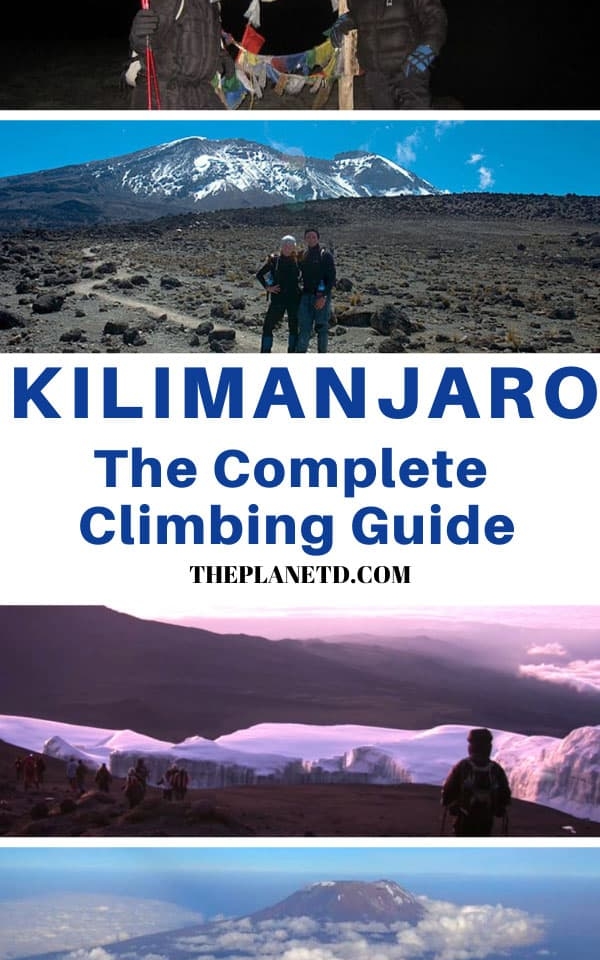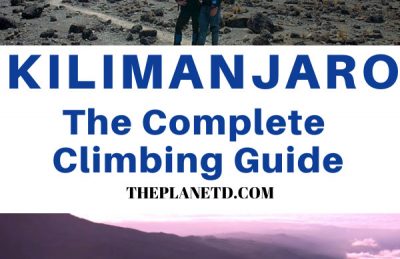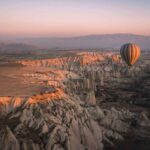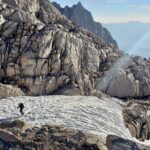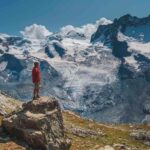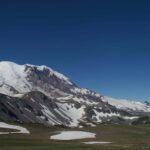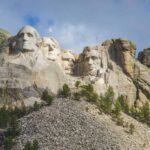I have to clarify a giant misconception about climbing Mount Kilimanjaro. It is not easy! Before we climbed Mount Kilimanjaro, we were often told, “Anyone can do it.” or “Oh, it’s an easy climb” Not true!
We were climbing in a group of seven strong individuals who had just finished cycling 4500 km down the continent of Africa through the hot deserts of Sudan and relentless mountains in Ethiopia – but we all agreed, Climbing Mount Kilimanjaro was one of the most physically challenging experiences of our lives.
How Hard is it to Climb Mount Kilimanjaro?
Yes, climbing Mount Kilimanjaro was difficult, but it was also one of the most exhilarating moments we’ve ever had. I am happy to say that our entire group all made it to the summit.
To give you an idea of what we were up against, there was another group of 22 people at our camp and only 9 of them reached the summit. That’s less than fifty percent. 65% is about the average success rate of climbing Kilimanjaro putting all the routes together.
Some routes have a higher success rate but cost more and take longer and others have a lower success rate. You can read our breakdown of Kilimanjaro routes here. But if you take proper precautions and are reasonably fit, you have a good chance of making it to the summit.
We are going to tell you exactly what to expect when climbing Mount Kilimanjaro from landing at the airport to reaching the summit.
How Altitude Affects the body
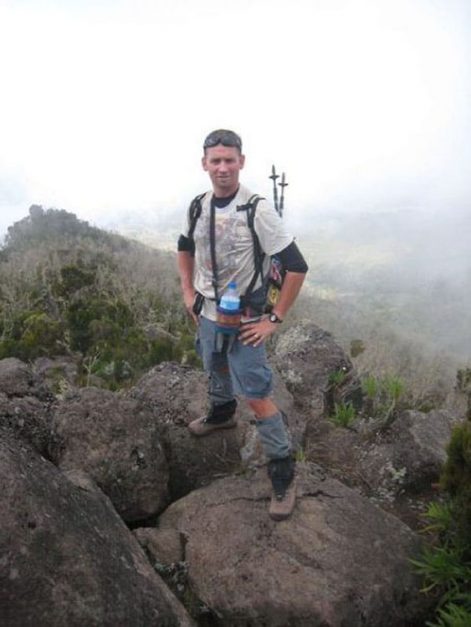

Mount Kilimanjaro is high. It is 5895 meters high and the trek starts in a misty jungle rainforest. So you will feel the altitude. It doesn’t matter what shape you are in when climbing to altitude. Your body never knows how it will react until it gets there.
I’ve heard of marathon runners not being able to climb mountains and I’ve heard of heavy cigarette smokers having no problem at all.
When you reach altitude, you will probably experience at least one of these symptoms
- Headache
- nausea
- dizziness
- loss of appetite
- lethargy
- difficulty sleeping
- I almost always have tingly hands.
We saw many people throwing up on our way down from the summit. Be very careful and watch out for signs of acute altitude sickness. If symptoms are mild, you will be okay if you take it slow, but if they progress, you should turn around. When symptoms get severe, it is important not to go up any higher.
The best advice I can give you is that if you want to make it to the summit of Mount Kilimanjaro, climb to altitude somewhere first before you fly to Tanzania.
That way you will know how your body reacts to altitude and you will be prepared for the feeling. The effects of altitude can be quite unsettling but if you know what to look for it won’t freak you out as much once you feel it.
It doesn’t matter what shape you are in when climbing to altitude. Your body never knows how it will react until it gets there.
Arrival at Mount Kilimanjaro Airport
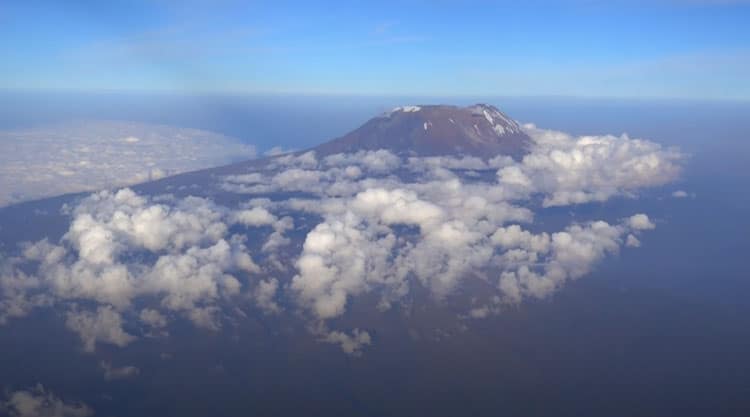

We flew to Kilimanjaro Airport in Tanzania from Addis Ababa in Ethiopia. Most flights will arrive at Kilimanjaro Airport located between Moshi and Arusha.
As we soared over Mount Kilimanjaro, I felt a pang of both excitement and fear. It was Dave’s birthday and to celebrate, we were climbing Africa’s highest mountain. Kilimanjaro is one of the great mountain treks in the world.
We had been cycling Africa for the past 2 months and were in the best shape of our lives. We were ready to tackle this mammoth peak but were a bit worried about facing sub-zero temperatures.
Best Shape of Our Lives – Ready for Kilimanjaro


Cycling doesn’t lend itself to carrying heavy hiking boots and warm weather gear, so once we arrived at Kilimanjaro airport, it was time to search for not only an operator to take us up the mountain, but also some reliable mountain climbing gear.
We rented our gear from our tour operator which they included in our trekking price. They supplied:
We hailed a taxi and made our way to Moshi on the advice of our driver. After a 45 minute drive taking in the lush landscape along the way, we arrived at Kessy Brothers Tours.
Our driver recommended this local tour operator called Kessey Brothers and we ended up loving their service and price. After working out a deal, we signed up for the Machame trek up Kilimanjaro the following day.
Machame Route – The Whiskey Route of Kilimanjaro


We chose to climb the Machame Route. Also known as the Whiskey Route. This seven-day climb up Mount Kilimanjaro is more challenging than the more popular five-day Marangu Route. (AKA the Coca Cola Route) .
You can choose either six or seven days on the Machame Route. If you have the time, we recommend taking the longer option.
The Machame Route is not only more beautiful and challenging, but it offers a better chance of summiting since we had an extra day to acclimatize to the altitude. This is very important to help anyone make it to the summit.
Day 1 – Climbing Mount Kilimanjaro
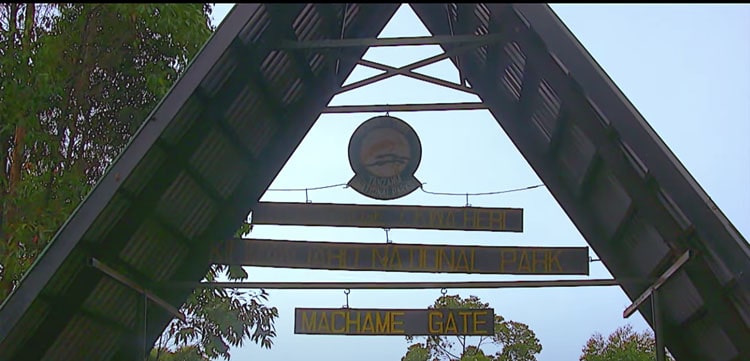

The day begins with a drive through a lush jungle setting where we entered Mount Kilimanjaro National Park at the Machame Gate.
After signing in at the park headquarters, we set off for a five-hour trek up the mountains.
Mount Kilimanjaro is one of the most unique climbs in the world as it starts in the jungle going through several different eco-systems before reaching the glacier.
The Kilimanjaro Climb Starts in the Jungle


Drenched in sweat, we followed our guide, Coleman through the jungle path. A soft spoken gentleman who kept reminding us to slow down by saying”pole, pole” (Swahili for slowly, slowly).
Time went fast as we marvelled at the fact that we were actually climbing Mount Kilimanjaro! We reached our first camp, The Machame Hut at 3,000 meters (9842 feet) and already felt the effects of being at altitude.
Machame Hut Camp


Luckily, we had the evening to rest and do nothing, as our climb up Kilimanjaro was fully catered. Tents were already pitched and soup and beverages were waiting for us to rehydrate and replenish our electrolytes.
The hot and humid temperatures of the day, gave way to a chilly evening. As we dined on a hearty pasta dinner in our dining tent, we were already thankful for the extra layers.
Night Time on Kilimanjaro
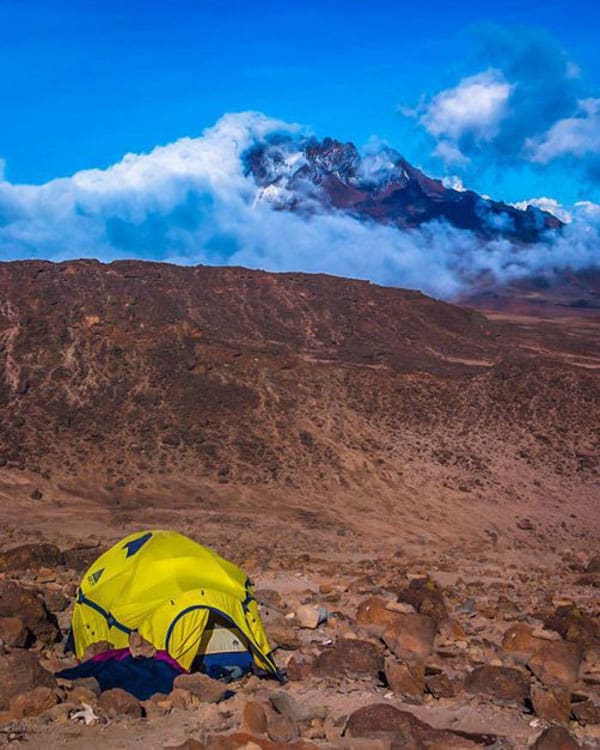

It was early to bed as we still had six days ahead of us, but not before catching our first glimpse of Mount Kilimanjaro.
The sun lit up its snowy peak as it set over the African savanna and we said to ourselves, are we really about to climb up there in just a few short days?
The camp was quiet as we watched the night sky light up with an incredible display of stars. We weren’t sure if we were nervous or confident but a wave of calmness came upon us and we drifted off to sleep as the Southern Cross seemed to bid us goodnight.
Day 2 on Mt. Kilimanjaro
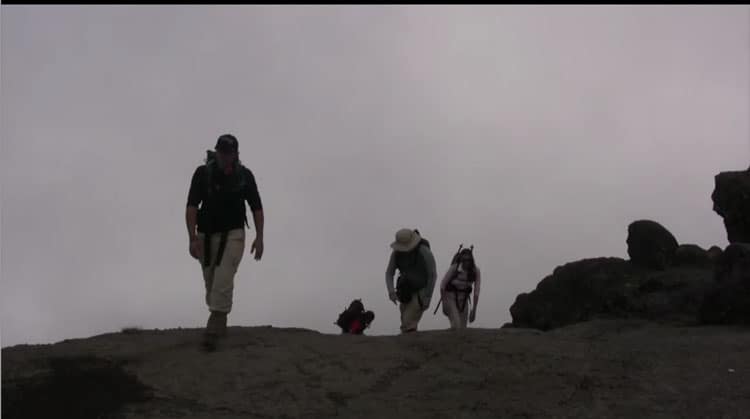

The landscape changed again on Kilimanjaro as we passed through the moorlands. This landscape was completely unexpected as the temperature rose and fell as clouds rolled through creating mist and fog one minute with hot sun and clear skies the next.
The elevation gain today is only 900 meters, but we covered a lot of ground going up and down crossing valleys and rivers. The landscape changed in front of our eyes as the green forest gave way to more shrubs and low grass. The scenery was gorgeous feeling more like an the arctic tundra than the heart of Africa.
We were tired but hadn’t felt too many effects of altitude. We had settled into a solid pace and were feeling strong. The cliffs grew steeper until we made our way to camp 2, Shira campsite. Tonight we camped above the clouds. We were all in now!
Day 3 – Acclimatization Hike


Today on the Kilimanjaro trek was a fun day to explore. An acclimatization day consists of going to a higher altitude, but coming back down to a lower elevation sleep. From 3900 meters, we climbed to 4600 meters to help get our bodies used to the height.
The trees had almost disappeared from view and all that lay before us was a huge valley with Mother Kilimanjaro looming overhead. Rock formations and lava tubes scattered the valley as we stopped for a photo of the famous Shark Tooth Formation.
No other trek on earth has so many ecosystems to hike through as Kilimanjaro.
The day was beautiful. Blue skies and sunshine offered unobstructed views and we basked in the beauty before our eyes, marvelling at how lucky we were to be able to witness The Roof of Africa.
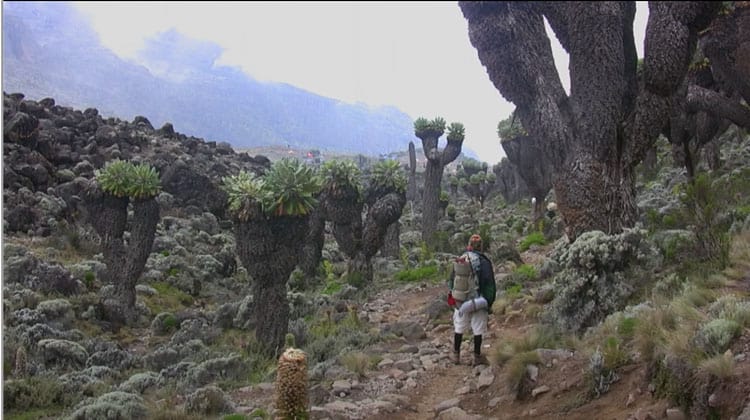

The most awe-inspiring site was hiking through a forest of giant cacti strewn amongst the massive boulders on our way back down to our next camp, Barranco Camp.
Dave and I took our time each day capturing photos and videos arriving to camp last each day. But we knew we were doing fine as our guides kept yelling “pole, pole.”
Climbing Kilimanjaro is not a race and we were grateful to take our time while on the trail soaking in these once in a lifetime views. Even arriving to camp late gave us plenty of time to rest and relax. We wouldn’t have it any other way.
Day 4 – Barranco Wall
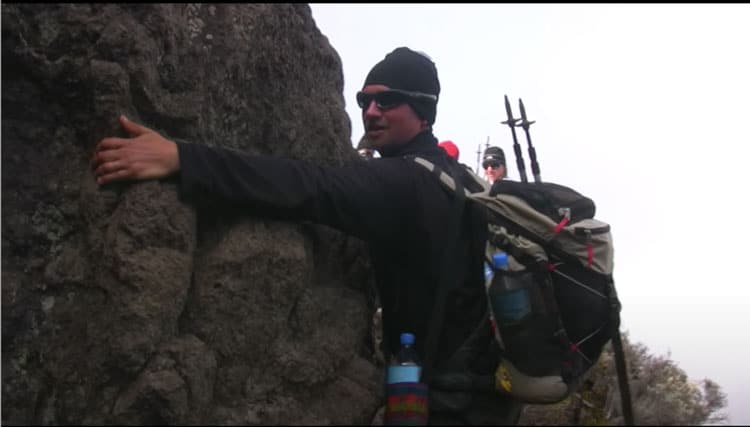

The next two days were exciting as we scrambled up sheer rock faces of the Barranco Wall. This was the most exciting part of our Mount Kilimanjaro climb. Keeping three points of contact at all times, we scaled 257 meters (843 feet) above the Barranco Valley.
As we clung to the side of the cliffs, we were in awe of the porters who managed to gracefully maneuver the cliff with hands in their pockets and heavy loads on their heads.
Once we reached the top of the Barranco Wall, it was another few hours of hiking through the Karangu Valley which was our last water point before the summit.
Camping above the Clouds
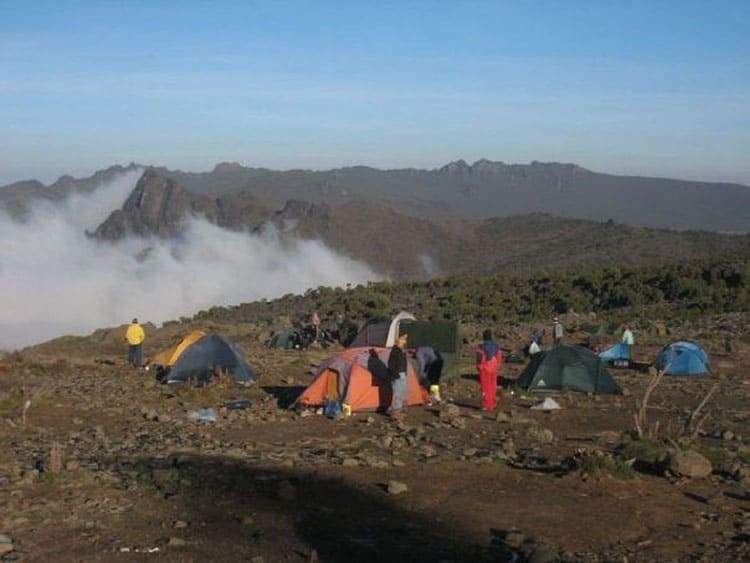

Arriving at Karangu Camp our jaws dropped seeing our tents set up above the clouds overlooking a deep valley. Things were getting real now! We relaxed at our camp enjoying a hearty meal, and sunset over the clouds. We didn’t do a lot at night, we kept warm in our sleeping bags in the tent as we conserved our energy for the day ahead. By the time we finished dinner and chatted with our fellow climbers about the day’s experience, we were ready to drift off to sleep high above the clouds.
Day 5 – Mweka trail to Base Camp


Day five took on our Kilimanjaro trek us over a barren landscape as the glacier loomed overhead. This was a shorter day, but it was much needed. When climbing the Whiskey Route you have a choice of 6 or 7 days. We didn’t take any chances, and booked a seven day trek to ensure a good chance of reaching the summit.
The longer your body has at altitude, the more prepared it is for staying strong and being able to finish. We had an early dinner and went straight to our tents to try our best to sleep. It’s difficult sleeping on Kilimanjaro. You are excited about the life changing day you just had and anxious about tomorrow all at once.
Day 6 – Mount Kilimanjaro Summit Day Uhuru Peak
It was a fitful sleep (nap really) before the morning of our Mount Kilimanjaro Summit day. filled with nerves and excitement. It seemed as though we just fell asleep when our guides woke us up at 11:15 pm.
After hot tea and cookies, we were on the trail at midnight making our final push to the 5,985-metre summit. The air was freezing and we looked up to see trails of headlamps already up the mountain. Other groups had left hours earlier. But we felt strong and confident that we would still make it in time for sunrise.
We pushed forward for six hours, steadily passing other parties without a word. There wasn’t a lot of talking, it was a time to push through the pain while suffering in solitude. Our minds were clear and the morning was silent.
The Mood Quickly Changed


At about 5500 meters, we all started feeling it, the altitude was taking its toll. Where we once felt confident and invincible, we had now hit that dreaded wall and it took every effort to move one foot in front of the other.
As the hours passed, doubt crept into our minds as we gasped for air taking sips from our freezing water bottles that were quickly turning to ice. Our legs felt like lead and our lungs couldn’t suck enough oxygen. We’d collapse to the ground trying to catch our breath during what short breaks we had.
A couple of us had diarrhea. One fellow in our group swore he had an out of body experience, and Dave mentioned later that he was literally falling asleep he walked. We all just wanted to curl up and go to sleep. But we carried on concentrating on putting one foot ahead of the other.
Our guide Coleman would only give us a limited break. He knew that if we stopped for too long, we wouldn’t get back up. It took all our will to push forward.
Reaching the Summit of Mount Kilimanjaro


Clearly our guide Coleman had been reading our progress throughout the week knowing exactly when to leave camp and how quickly to walk because he timed our summit at the precise moment the sun broke through the clouds to reveal a glorious sunrise on Mount Kilimanjaro.
Our group was alone at the famous summit of the Kilimanjaro billboard and although we were happy, it was a quiet celebration we thought it would be. In fact, reaching the summit of Mount Kilimanjaro almost felt anti climactic.
It was -24 degrees Celcius without the wind. It felt more like -40 degrees with the windchill.
Perhaps it was exhaustion, perhaps fatigue, and suffering the effects of altitude, but at this point, we hadn’t felt the euphoria we expected. Instead, we quickly snapped our photographs offering a mild almost monotone congratulations to each other. We snapped some photos by the sign as our hands quickly froze and then we started back down as soon as possible.
We still had 2 1/2 hours to go back down to camp, and there was nothing we wanted to do less in our lives!
The summit day of Kilimanjaro took an entire nine hours to complete. Six hours trekking up the mountain to the summit, a half hour at the summit and another 2 1/2 hours to go down.
The Descent from Kilimanjaro Summit
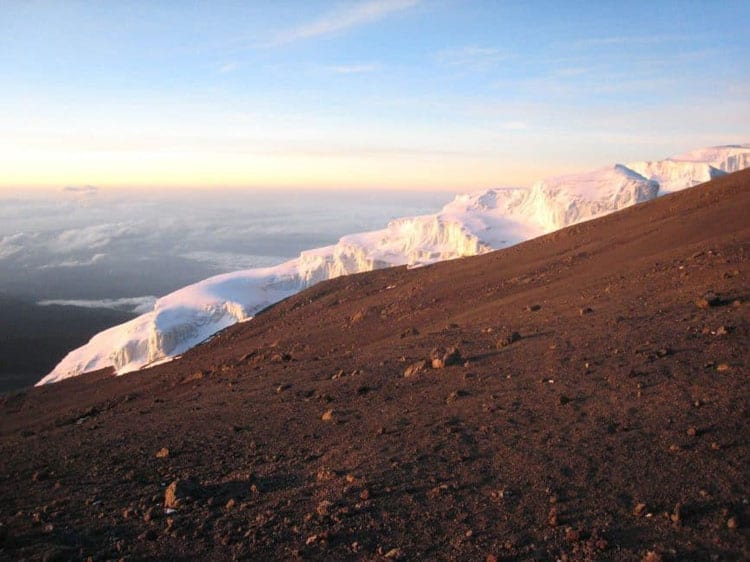

On our way down from the summit, we got a chance to see what we climbed that night. I am glad we did it in the dark, I would have been terrified if I actually saw the sheer drops and steep grades that we faced on the way up to Kilimanjaro.
We made our way down as fast as we could sliding in the scree. Once we got the hang of running down the scree, things became easier. It was almost like skating as we let the loose rock take us down the mountain as we glided above.
With a quick stop for food at our previous night’s camp, we continued on to an altitude of 3,000 meters where we had our final night’s rest on Mount Kilimanjaro.
A Really Long Day
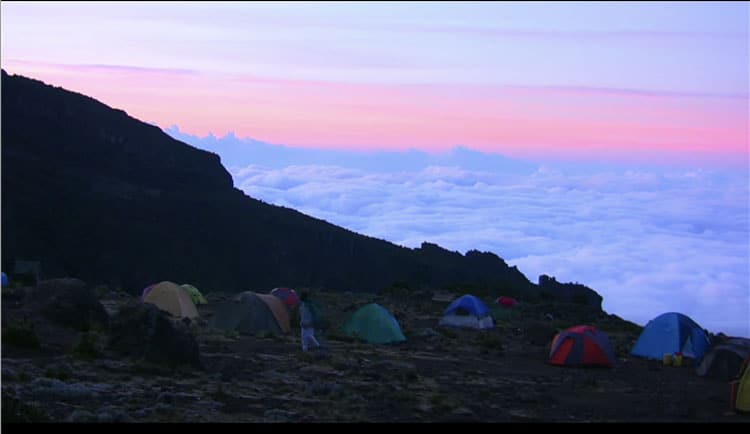

In reality, our summit push combined with our descent was a punishing 30 hours of trekking on Mount Kilimanjaro. The descent was steep and slippery. I must have fallen 15 times. The fatigue was huge and missteps happened a lot.
Descending Mount Kilimanjaro is hard. Hard on the knees, the calves, the thighs, and the mind.
We passed several parties on our way down after reaching the top who were throwing up, giving up, and wanting to go on, but had no chance of making it because they just had too far to go. People kept asking us if it was much further and knowing how I felt when climbing Mount Kinabalu years ago, I had to be honest. In reality I said, yes, you have a long way to go. I hope they made it, but it was getting late.
We finally made it to our tents at camp by 3:30 pm and were ready to collapse. We crawled right into our tents for a solid nap. We hadn’t even had a chance to celebrate yet that we had reached the summit of Mount Kilimanjaro. All we wanted to do was sleep.
After our short nap at low 3000 meters in altitude that we finally felt the elation we expected to have at the summit. We just climbed Mount Kilimanjaro baby! Having a celebratory toast of champagne, we instantly forgot the pain and suffering of the last 24 hours.
Last night we were asking ourselves what are we doing and vowing to never step foot on a mountain again, and today we were already planning our next trek to Everest Base Camp. How quickly the mind forgets.
The final two days of climbing Mount Kilimanjaro were literally one of the hardest things I have done in my life. But we had conquered Mount Kilimanjaro and lived to tell the story. I’ll never do it again, but I am so glad that I did.
Final Day on Mount Kilimanjaro
The following day, all that was left was an easy two-hour walk to the bottom of the mountain, where we collected our Climb Mount Kilimanjaro certificates and exchanged stories with fellow climbers.
Having spent six days on the mountain without a shower and wearing the same clothes that we started in, we felt dirty and smelly, but we didn’t care – we had just climbed Africa’s highest peak.
We had a beer at 9:45 am to toast our guides and fellow climbers and literally bought the T-shirt. We had been there, done that and bought the T-shirt to prove it.
Update: Great news, Mount Kilimanjaro now has high-speed internet. With broadband towers
officially connected by Tanzania Telecommunications Corporation, climbers can count on staying connected and utilizing the mountain’s improved safety measures.
Relax after Climbing Kilimanjaro in Zanzibar
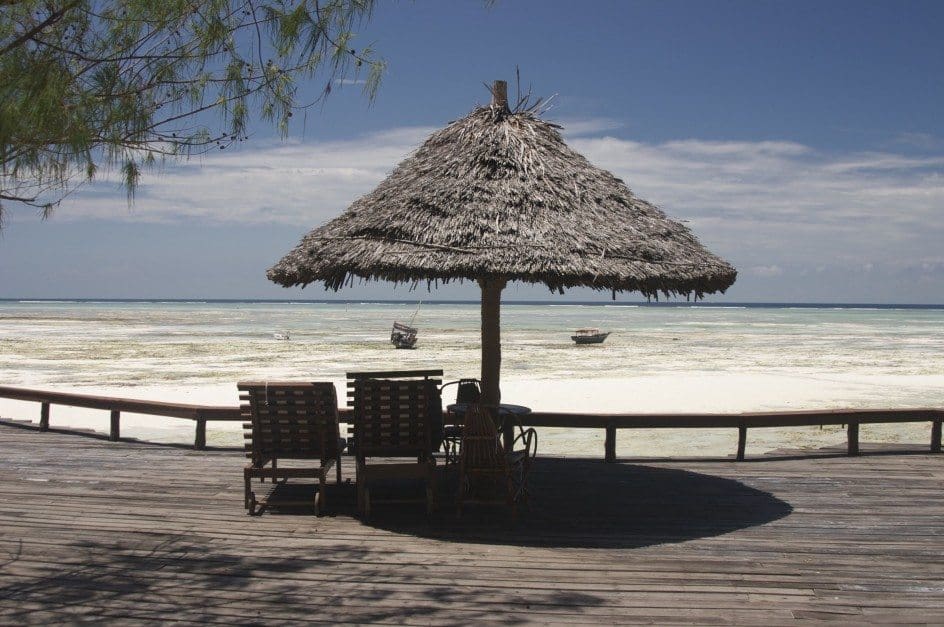

Ending our Mount Kilimanjaro Trek with a flight to paradise was the perfect way to end the trip. We hopped aboard a small plane from Mount Kilimanjaro airport and made our way to the spice island of Zanzibar.
Zanzibar is Tanzania’s island destination and we spent a few days lounging on the beach, soaking in the sun and mending our aching muscles.
It wasn’t long before we forgot the pain and suffering and soon started telling everyone we met “that climbing Kilimanjaro wasn’t so bad, anyone can do it! Ahhh, Climbing Kilimanjaro was magical and now we feel like we could conquer anything. But first, we must chill. Hakuna Matata (No Problem).
What to Pack to Climb Mount Kilimanjaro
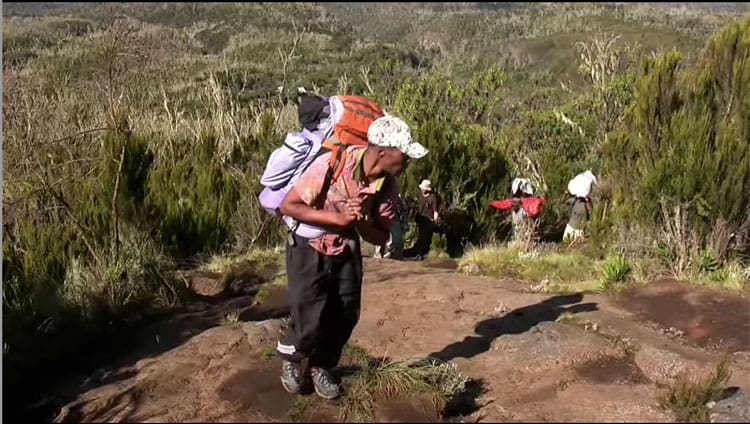

We have done many high altitude treks since Mount Kilimanjaro and can attest that our gear wasn’t optimal since we were cycling Africa. If we were to do it again, this is what we’d pack.
Packing List for Kilimanjaro
- Broken in Hiking Boots – Do not use them for the first time on the mountain.
- A good day pack that has water bottle holders
- two water bottles (one insulated)
- Or a Bladder to put inside your day pack for insulation.
- Steripen – to sterilize our water with ultraviolet light. Easy and fast and doesn’ thave the after taste of purification tablets.
- Purification tablets – keep on hand for a back up to purify water
- Layers – Breathable base layer, (legs and top) – an insulating layer, wind and waterproof outer shell.
- Zip off Trekking Pants – weather changes regularly from hot to cold.
- Breathable Trekking Shirts
- A Down Winter Coat
- 2 pairs of sunglasses (should one break which mine did on this trek)
- headlamp with extra batteries
- Portable USB charger for cameras and headlamps.
- Warm winter hat
- Merino Wool Beanie
- Peak hat for daytime – One with a headlamp built in is awesome.
- Buff or balaclava
- liner gloves
- Warm mittens
- Camp shoes – you won’t want to be in your hiking boots 24/7
- 3-4 pairs of socks so they can dry out between climbs. And to change into dry socks at camp.
You may need to invest in a tent, and sleeping bag if not provided by the company. We almost always use the outfitter’s gear as it is made for the conditions and we usually travel light.
What Kilimanjaro Route to Choose
- Machame Route – 6 or 7 Days This was the route we took and loved it. It is one of the most beautiful routes as well. The 7-day option has a higher success rate. 80% success rate for 7 days, 70% for 6 days. It is challenging with scrambling at the Barranco Wall.
- Marangu Route – This is a good route if you want to stay in huts. It is the most popular and most crowded as it uses the same trail up and down. It is the most affordable, but it also has the lowest success rate of about 40%.
- Lemosho Route – 7 or 8 Days. This is Kilimanjaro’s newest route and is said to be the most beautiful. Plus it has far fewer crowds than the other routes. But it is more expensive. It has a 90% success rate!
- Northern Circuit – 9 or 11- days Another good option for success rate. It is much longer staying at lower altitudes for longer.
- Rongai Route – 6 or 7 Days. A good option for the rainy season as it starts on the north side of the mountain.
Kessy Brothers has a full breakdown on their website. And I recommend doing the research to see which route fits your budget, your skill level and the amount of time you have in Tanzania.
We know that travellers often have a limited time and want to combine a trek with a safari and a trip to Zanzibar. If only we all had deep pockets and unlimited time right?
How Much Does it Cost to Climb Kilimanjaro?
A Mount Kilimanjaro Climb Cost can vary greatly. If you have the time and can book once you arrive, you will get a great deal. Booking local cuts out the middle man and you don’t have to pay western rates.
Tours can be booked in Arusha or Moshi. Arusha is more of the main hub for travelers who are also going on safari.
On Average, treks up Mount Kilimanjaro begin at $2000 USD. By booking in Moshi, we paid less and felt that our tour was just as good as the others we saw. Perhaps our tents were the matching glam tents, but we had excellent service and meals.
Be sure to tip your guides, we suggest 10-20% of the cost. They work hard and are paid very little.
Kilimanjaro Tour Companies
We really enjoyed climbing with Kessy Brothers based in Tanzania.
You can book Kilimanjaro Climbs through organized tour operators like Intrepid Travel and G Adventures who are both reliable and good companies.
For more luxury you can go with Abercrombie & Kent, Geographic Expeditions, or Lindblad.
Read More Great Climbs that We’ve Done
Check out More Tanzania and Africa Travels
